
Ōita
From Kagoshima to Ōita
I had been in
Kagoshima
for a few days, observing
Sakurajima,
Japan's most active volcano.
Now I would move on to northwestern Kyūshū
and the city of Ōita.
I would take the Shinkansen bullet train to
Kokura Station in Kitakyūshū,
at the northern tip of Kyūshū,
and then a Limited Express train
down the Seto Inland Sea coast to Ōita.
I would see some prehistoric graves
at Ōita,
the Stone Buddhas near Usuki,
and Aso-san or Mount Aso,
Japan's largest active volcano.
Google Maps dynamically generates the map when you load this page. Depending on what time it is in Japan, you may see buses by a different route instead of my rail trip. I went north from Kagoshima Chūō Station through Kumamoto and Kurume to Kokura Station, at the northern tip of Kyūshū. Then southeast through Nakatsu and Beppu to Ōita. It was about an hour and forty-five minutes by Shinkansen to Kokura, and then about ninety minutes from there to Ōita.
I had purchased my ticket the day before my trip. It was in two segments. Train #554 was a Shinkansen or "Bullet Train". #27 was a Limited Express, meaning that it made some but not all of the stops between Kokura Station and Ōita.
#554 1155-1338 Kagoshima — Kokura #27 1409-1536 Kokura — Ōita
I packed up and left the Green Guesthouse where I had been staying in a capsule in a shared room. I walked a few blocks to the Tenmonkan shopping district, where coffee shops are found along with a wide variety of stores under the covered arcades. I had some coffee, then took the tram the rest of the way to Kagoshima Chūō Station.
The station is in a large complex with several floors of retail shopping. I had plenty of time before my train, so I had more coffee and watched the people. I was re-reading Joseph Campbell's Primitive Mythology, the first volume of his Masks of God series.
While I'm pretty sure that I now know more about Shintō than the average American, I'm not going to claim that I understand it. But then it seems that the average Japanese person doesn't understand much about it, either. Shintō is a cultural tradition for most people in Japan, and not really a religion as most languages define that concept.
Soon it was time to finish my coffee and pass through the ticket barriers. You get a stack of tickets for a trip like this.
The first is for transport over the overall route — Kagoshima to Ōita on this trip.
The second and third are for the supplements for the higher levels of service — Shinkansen on the first leg and Limited Express on the second.
The fourth piece is actually a receipt showing what you paid, not a ticket.
You feed the whole stack into the ticket machine, and it may retain some pieces. On this trip, for example, I would only have my receipt after I exited in Ōita at the end.
It was about 11:30 and my train didn't leave until 11:55.
There it is at the top of the display:
Train #554 leaving at 11:55 from platform 12.
And, just beyond that display, a shop with a variety of bentō meal boxes. I bought one and rode the escalator up to platform 12.

Kagoshima is at the southwestern end of the Shinkansen network. It used to take at least four hours to travel by train between the cities of Kagoshima and Fukuoka. Now the Shinkansen covers that distance in an hour and twenty minutes. My train was already at the platform, as this is the end of the network.

Looking down the track in the direction we would travel, the line disappears into a tunnel a short distance out of the station.
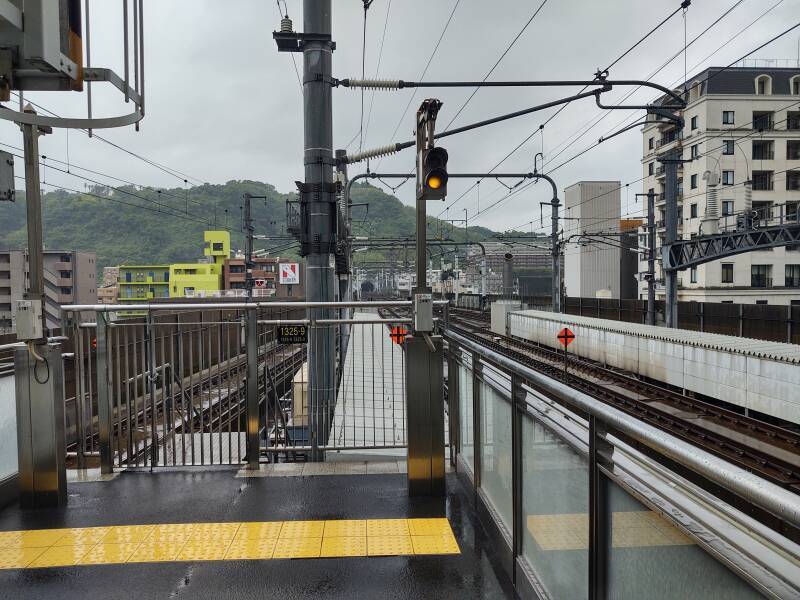
The section north from Kagoshima to Shin-Yatsushiro was the first segment of high-speed line built on the Kyūshū Shinkansen network. That section has 126 kilometers of rail line and 70% of that, 88 kilometers, is in tunnels.
A crew was cleaning the train before it began its trip. My train would transition to a different designation at Fukuoka. I would stay on board from there to Kokura, where I would transfer to a different train. This train would continue on to Ōsaka, reaching there four to five hours after leaving Kagoshima.
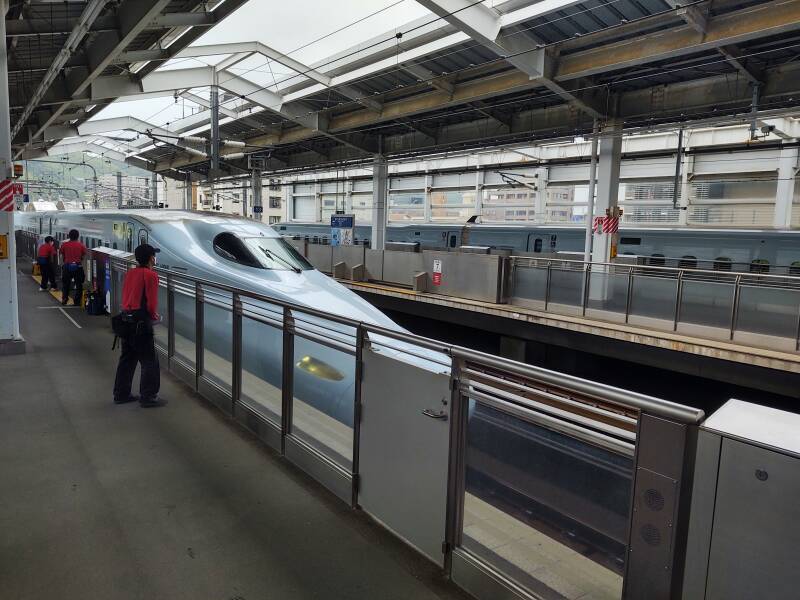
Standard gravity on Earth is 9.80665 m/s2, so the N700 series accelerates at 0.073 g.
The N700 series Shinkansen has operated since 2007. The trains have eight cars, always assembled with #1 at the Kagoshima end and #8 at the Ōsaka end. They have a top speed of 300 kph, and can accelerate out of the station at 2.6 km/h/s, or 0.72 m/s2. Whoosh.
Two to four trains run north every hour from 6:00 to 21:00, with the exception of just one 13:00–14:00, plus three more leaving between 21:30 and 23:00.
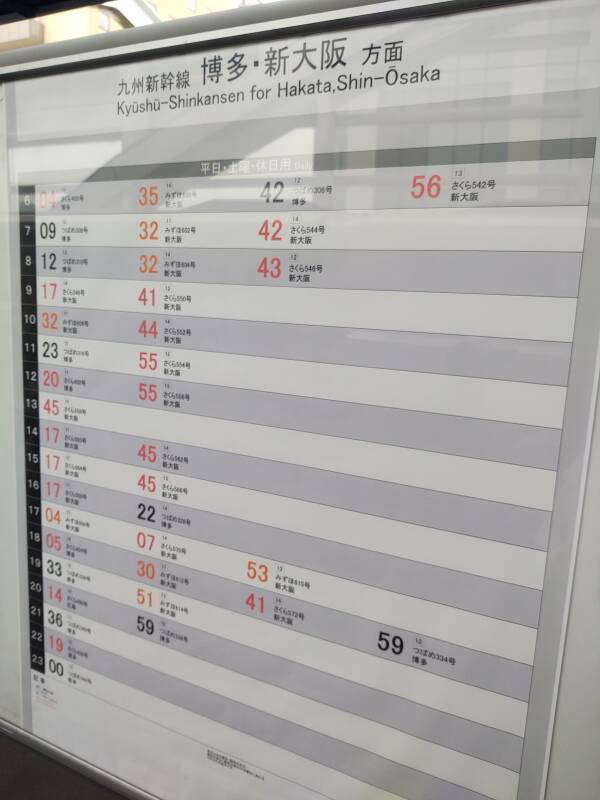
Boarding the Shinkansen
By 11:38 we were lining up, but the meticulous cleaning crew still had a little more to do. This is the Sakura service as shown on the overhead sign. The name means "cherry blossom" as in the name of the local volcano Sakura-jima or Cherry-Blossom Island.
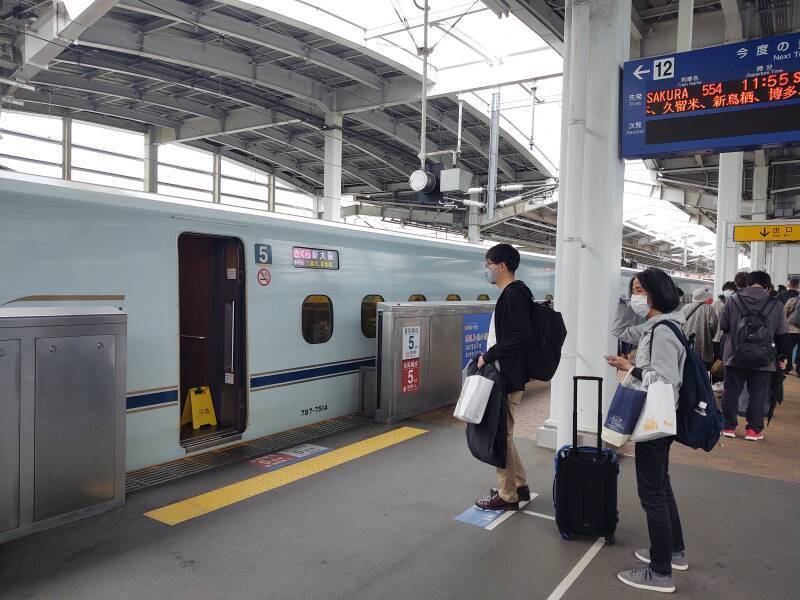
Soon it was time to board. I had asked for a window seat, as always. I had worn my mask through the station and onto the train. This was in May, 2023, a little over three years into the COVID-19 / SARS-CoV-2 pandemic.
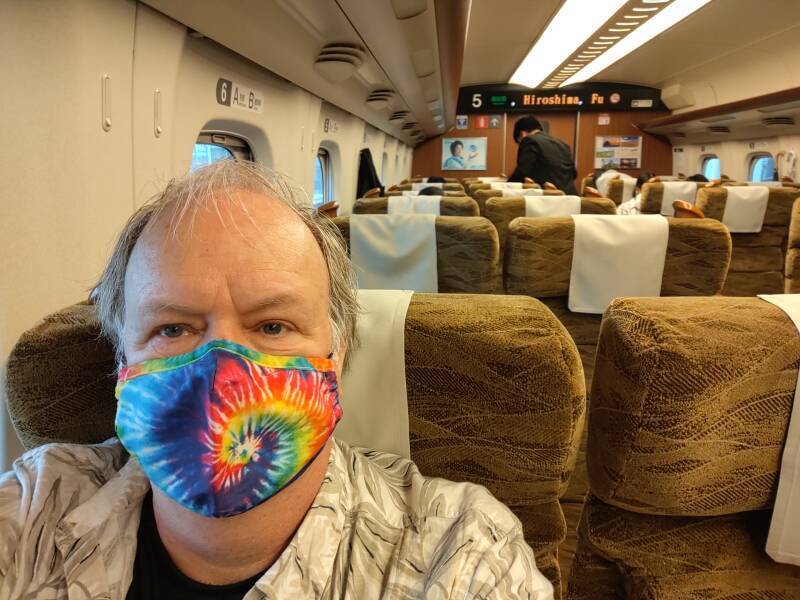
I had seen some people routinely wearing masks when I visited Japan on my own in 2017 and 2018. It was a small percentage in those pre-COVID days, maybe 5% of people, certainly less than 10%. Now the percentage was much higher, but still well under 100%.
I would put my mask on as I entered a crowded area, especially public transport stations. Then I would see what everyone else was doing, and follow them. That got me through four weeks in Japan without noticing anyone giving me a disapproving look. I did get a few "Ah, cool, tie-dye" looks, of course.
The majority of people getting onto the train in 2023 wore masks. And then the majority of those carrying meals removed them by the time we started rolling, which was precisely on time of course.
Here is my bentō. Notice that it cost just ¥ 462, about US$ 3.50 at the time. Of course it came with oshibori and hashi, a moist hand towel and chopsticks. The highball added no more than about ¥ 200.
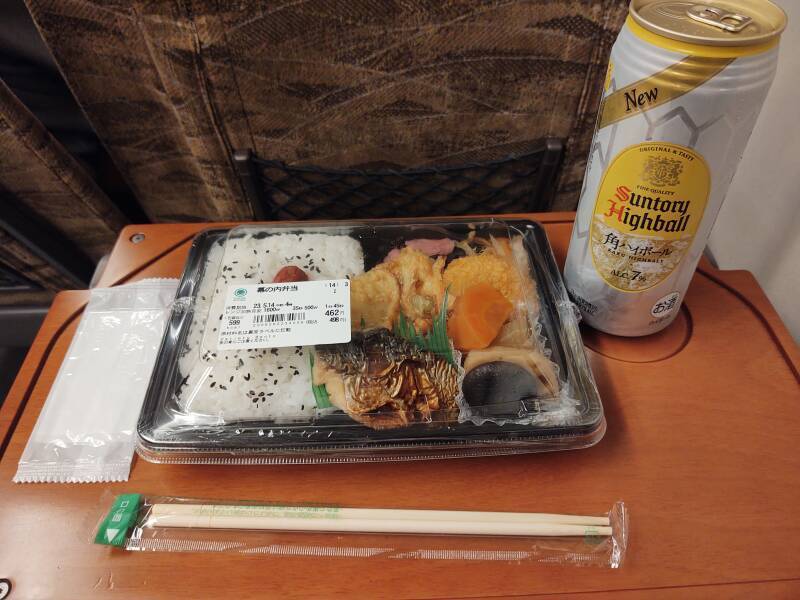
Grilled fish, steamed vegetables and mushrooms, a piece of katsu meat, a savory ball of something, pickled ginger, pickled vegetables, and rice.
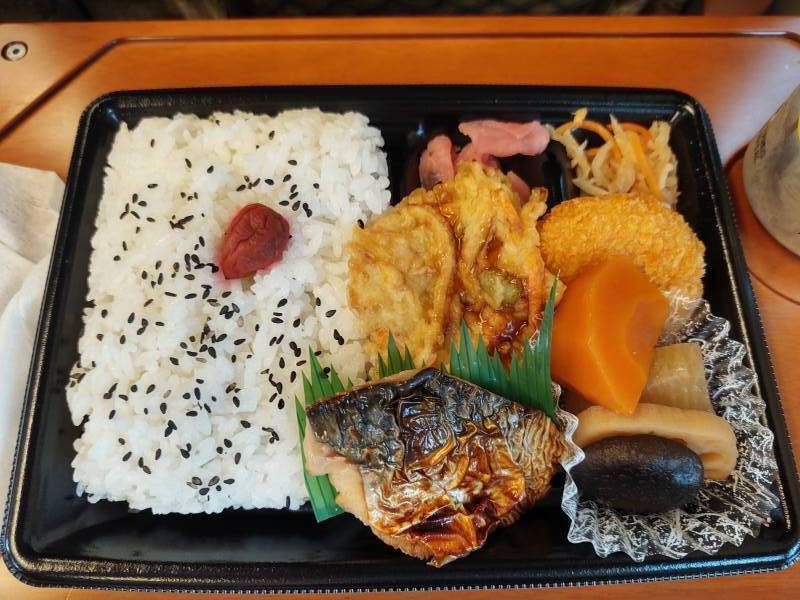
I ate my meal as we rolled north through the tunnels. For relaxing times, make it Suntory time.
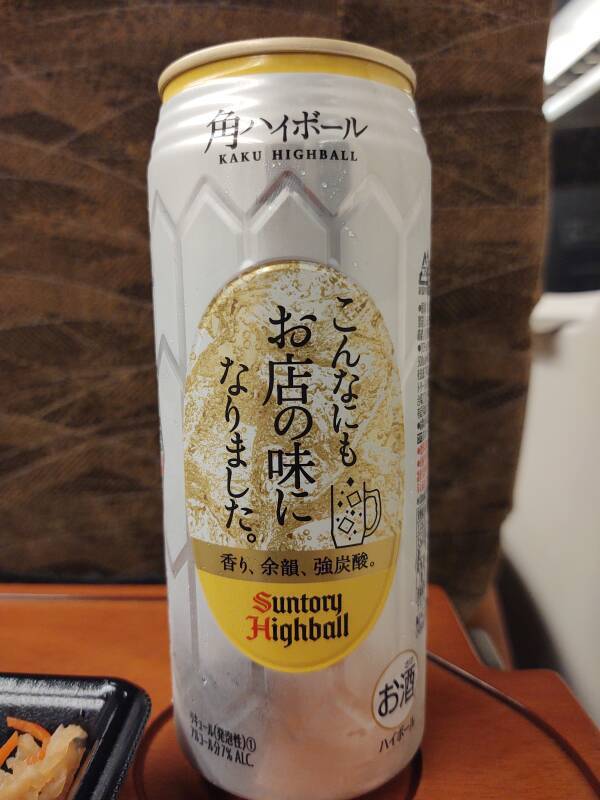
North Through Kyūshū
My phone's camera scanned its sensing array from top to bottom in this orientation. That distorts vertical objects in the foreground when you're moving at close to 260 kph, the maximum speed on the Kyūshū Shinkansen.
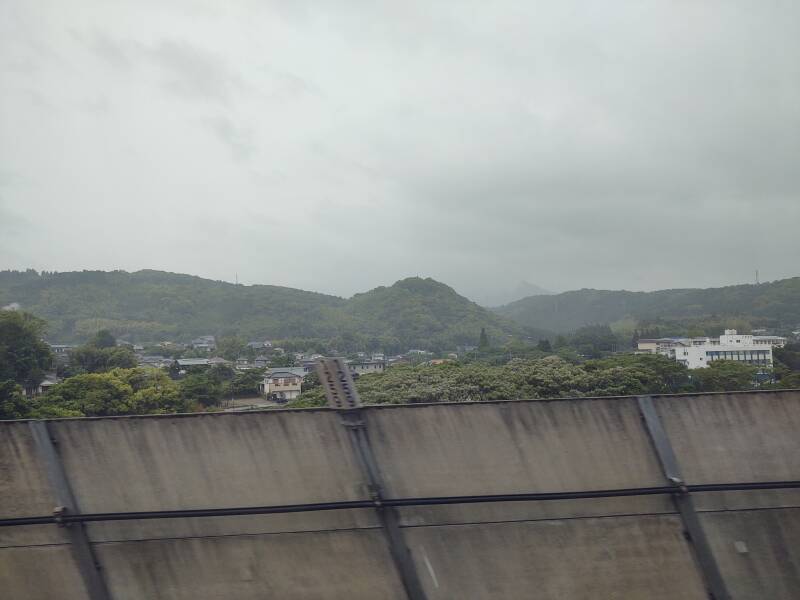
Trigonometry enthusiasts can calculate the distance to the distorted noise-controlling wall from train velocity, exposure time, and image geometry. The vertical members in the above and below images appear about 22° off vertical. The camera recorded an exposure time of 0.0006 seconds. Be prepared to show your work.
I had a clear view of the scenery beyond the noise-controlling wall running along much of the line.
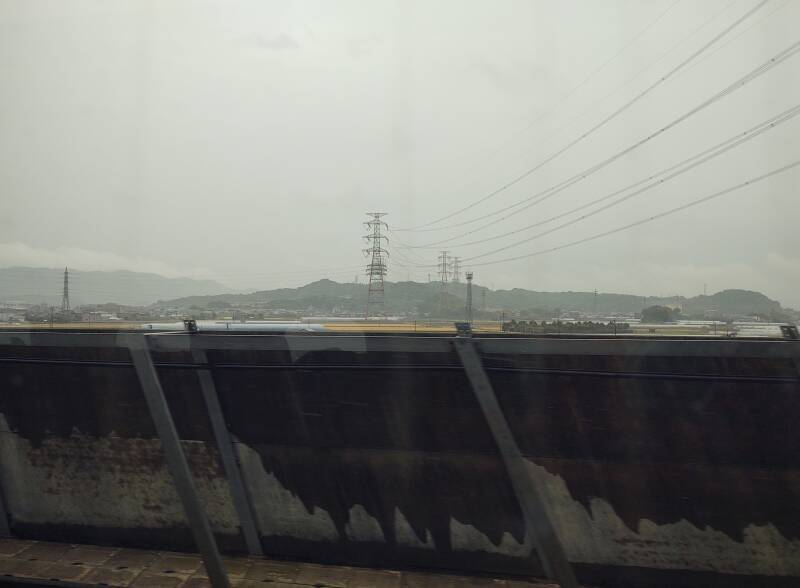
It was a dark day with low clouds and mist. Very atmospheric!
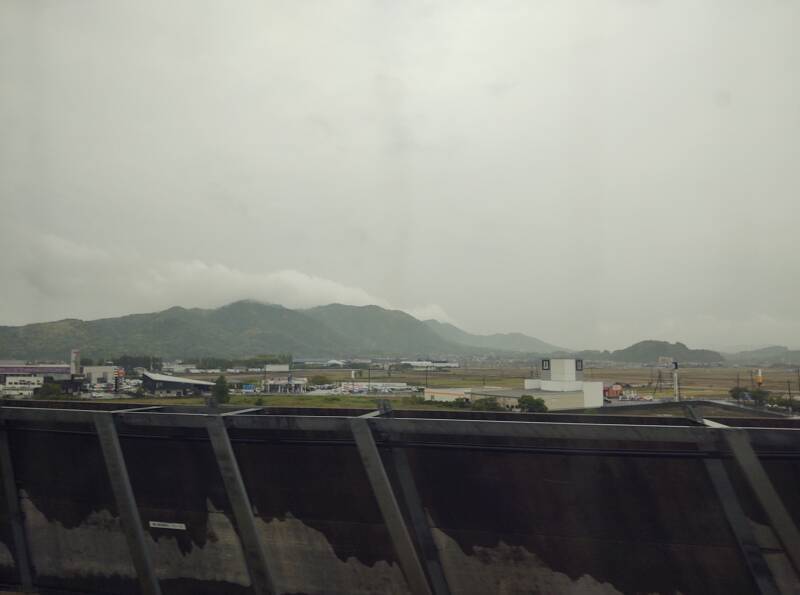

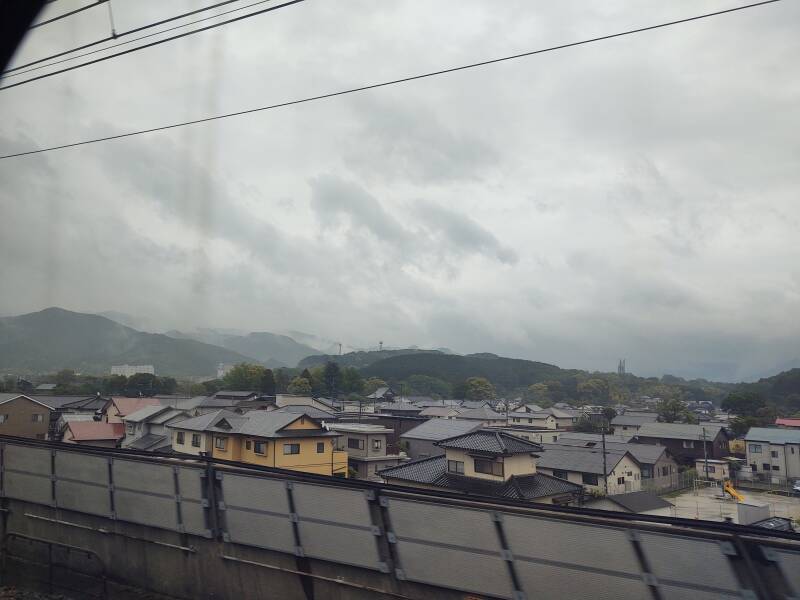
Shinkansen window photography frequently captures poles and guy wires. Usually it's a spoiled picture. Sometimes it happens to be a little interesting.
Counterweights suspended from pulleys maintain constant tension on the overhead catenary lines carrying electrical power for the train.
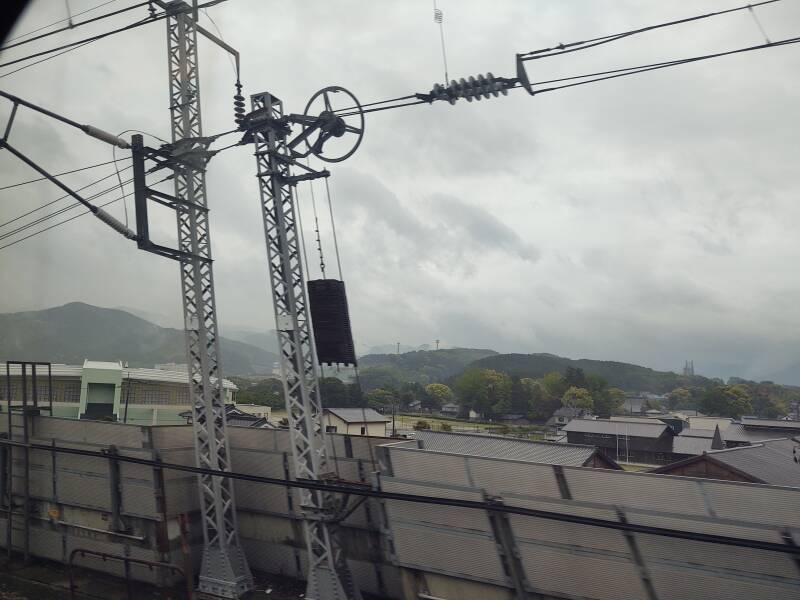
The Shinkansen runs on 25 kV AC power. Electrical power from the overhead catenary is distributed through the train. All the cars except the one at each end have electric motors driving their wheels. This provides faster acceleration and deceleration. It also distributes the motor weight, meaning that the track doesn't have to support especially heavy locomotives.

We stopped at Hakata Station, the main station in Fukuoka. Beyond there, we were on the Tōkaidō-Sanyo Shinkansen line joining Hakata and Shin-Ōsaka Station.
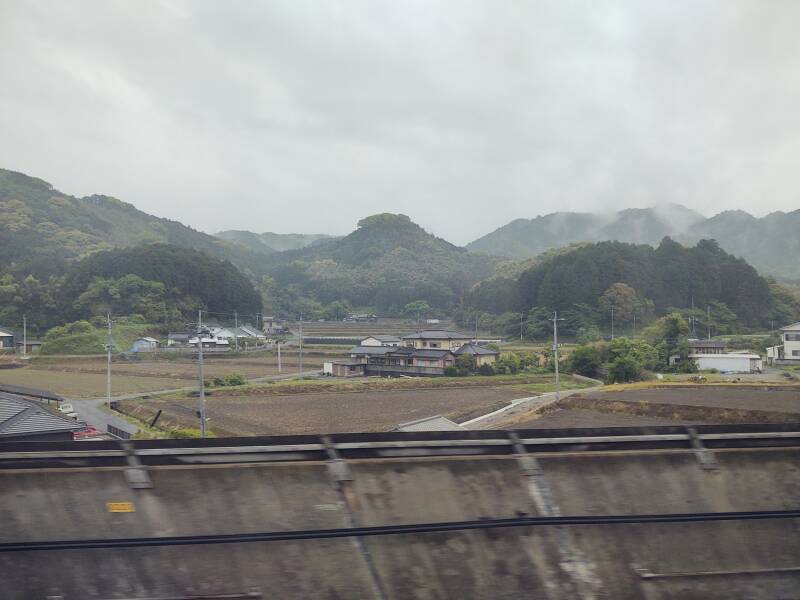
Changing Trains at Kokura Station
Kita (or 北 or きた) means "north". Kita-Kyūshū is the literally named city at the northernmost tip of the island of Kyūshū. The Kanmon Strait is a winding passage of water separating the main islands of Honshū and Kyūshū. Kokura Station is the main railway station in Kita-Kyūshū. It's the last stop before crossing to Honshū through a tunnel under the strait.

Small portion of 1:500,000 Tactical Pilotage Chart TPC G-11D, from the Perry Castañeda Library Map Collection at the University of Texas. Elevations and tower heights are in feet.
Back in 1863–1864, when it was called the Shimonoseki Strait, the Tokugawa Shōgun was barely holding onto power over Japan. Emperor Kōmei issued his "Order to expel barbarians", contradicting the Shōgun's program of loosening control over foreigners.
The Chōshū clan openly defied the Shōgun and followed the Emperor's new order. They began firing without warning on all foreign ships traversing the strait. The captain of a U.S. merchant steamship that came under fire reported the incident to the U.S. Consulate in Yokohama. French and Dutch merchant ships soon also came under fire.
The USS Wyoming was the first foreign warship to arrive. Its crew found themselves fighting three steam-powered warships that the U.S. had recently given to Japan. Oops. Embarrassing.
Meanwhile, in August 1863, the British were also involved in the Bombardment of Kagoshima, retaliation for samurai having killed a British merchant who behaved disrespectfully toward the warlord of the Satsuma Domain.
French, British, and Dutch warships soon arrived. The Wyoming left as the U.S. minimized its involvement, given that it had a civil war going on at home.
It built up to a two-day battle in September, 1864. The allied foreign countries demanded that Japan pay US$ 3,000,000, which at that time would buy about thirty warships.
The Shōgunate couldn't pay. The foreign countries greatly increased their demands to open ports to U.S. and European merchant ships.
Emperor Kōmei died in 1867 and his son became the Meiji Emperor as the Shōgun fell from power. The sweeping changes of the Meiji Restoration went into effect in 1868. Buddhism was suppressed, and Shintō was promoted in a form emphasizing the divine nature of the Emperor. Japan waged a series of wars that built up to World War II.
Several municipalities merged in 1963 to form Kita-Kyūshū. Its center was the ancient feudal city of Kokura, where the main railway station is located today.
VisitingNagasaki
Kokura was the primary target of the second U.S. nuclear mission, on August 9, 1945. It was partly covered by clouds. Yahata, a few kilometers to the west, was still burning from an incendiary bombing raid the day before. Smoke from those fires, plus a smoke screen made with burning barrels of coal tar, added to the clouds over Kokura and prevented positive target identification. That mission continued to Nagasaki, where the secondary target was briefly visible and the bomb was dropped.
I hustled to get out of the train at Kokura Station. Shinkansen station stops are short. You need to collect your stuff, move toward the doors, and be ready to step off the train as soon as the doors open.
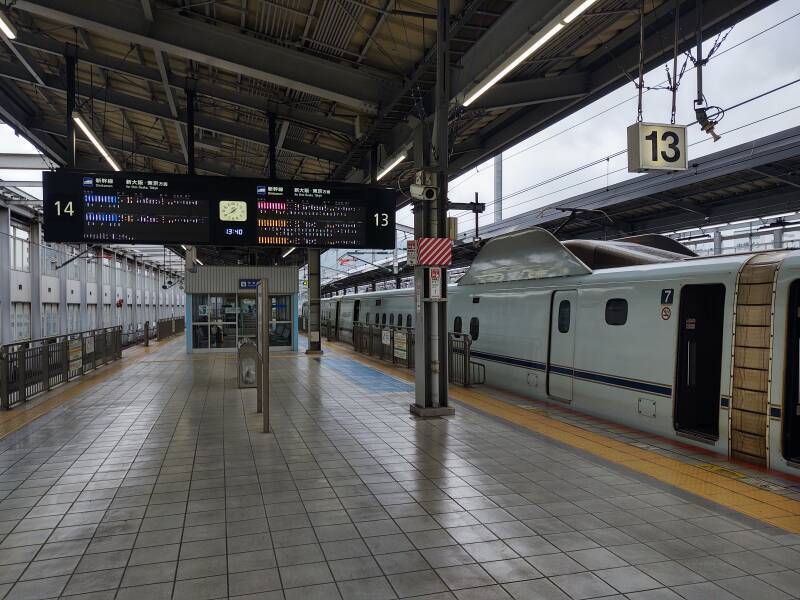
The train that brought me here soon accelerated out of the station. It would soon reach the 18.7-km-long Shin-Kanmon Tunnel that crosses under the strait to Honshū.
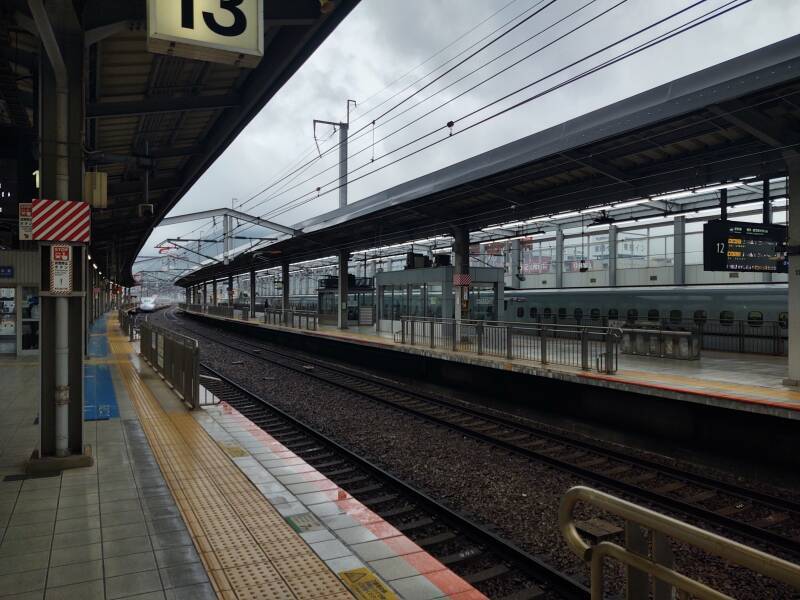
Of course they sell a wide array of bentō boxes within Kokura Station. And of course I bought one.
Display examples are above, boxes to buy are below. I still had a puzzle to solve, matching the rectangular example I wanted to a rectangular box down in the cooler section.
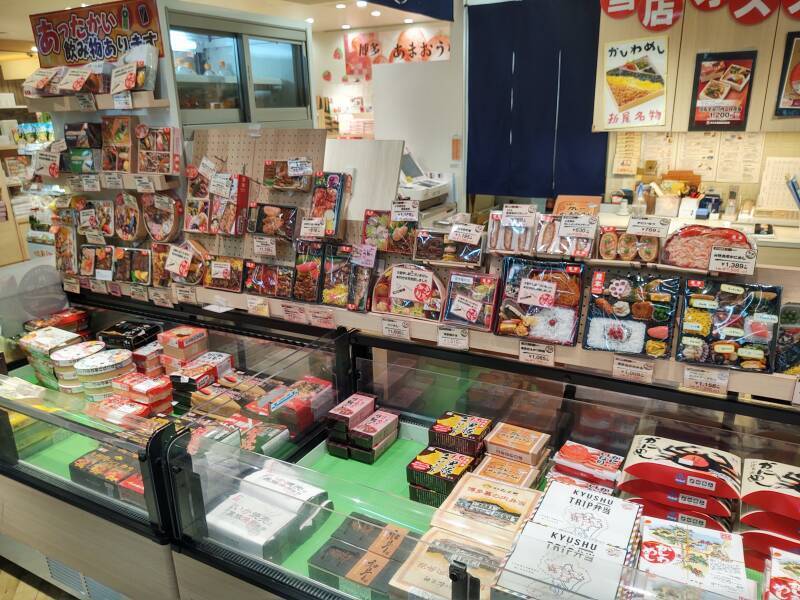
Here's the sign showing my train, #27 on platform 7 at 14:09.
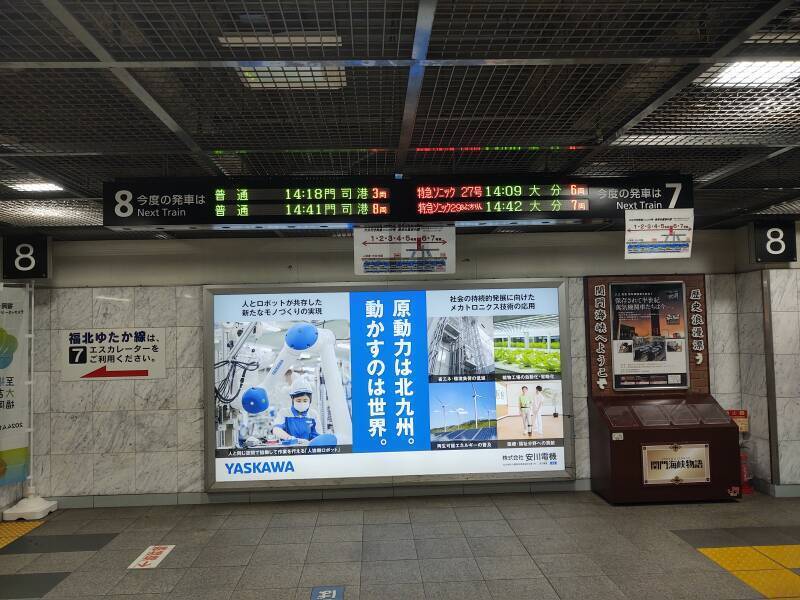
Wait a moment, and the sign will cycle through a romanji version. Yes, train #27 is the 6-car Sonic Limited Express for Ōita. Platform #7 at 14:09.

I was soon on the platform waiting for my train.
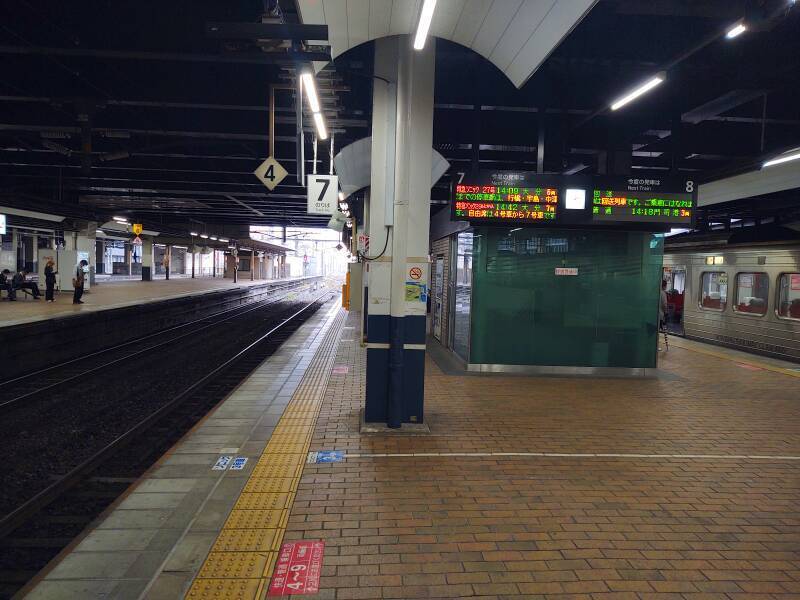
Sonic Limited Express to Ōita
A Local train stops everywhere. Express trains skip the small stations, and Limited Express trains stop only at the largest stations.
The Sonic Limited Express from Kokura stopped at three stations along the way — Yukuhashi, Nakatsu, and Beppu — before reaching Ōita Station.
Breakfast had been two cups of coffee. I decided to reclassify my Kagoshima-Kokura bentō as brunch. What I had purchased at Kokura was a late lunch bentō. I was on vacation! And, I had planned what turned out to be a long day of walking on the following day.

It was a two-level bentō.
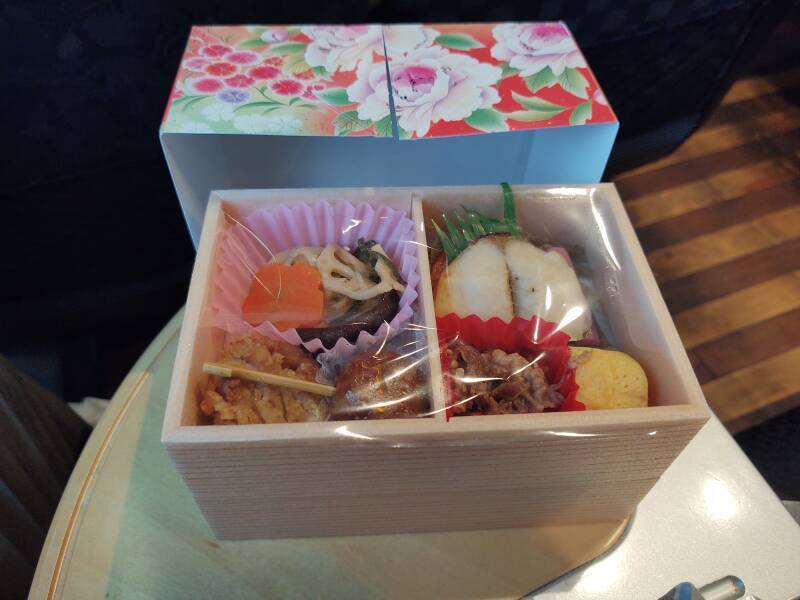
Each layer was sealed with plastic film. Oshibori and hashi were between the two levels.
The total cost for both bentō boxes was less than what a soggy meal of a sandwich and french fries would cost at McDonald's in Chicago's Union Station, where that's about the only choice most of the time.
Here I had grilled fish, meatballs, steamed and pickled vegetables and mushrooms, and rice with dried fish flakes.
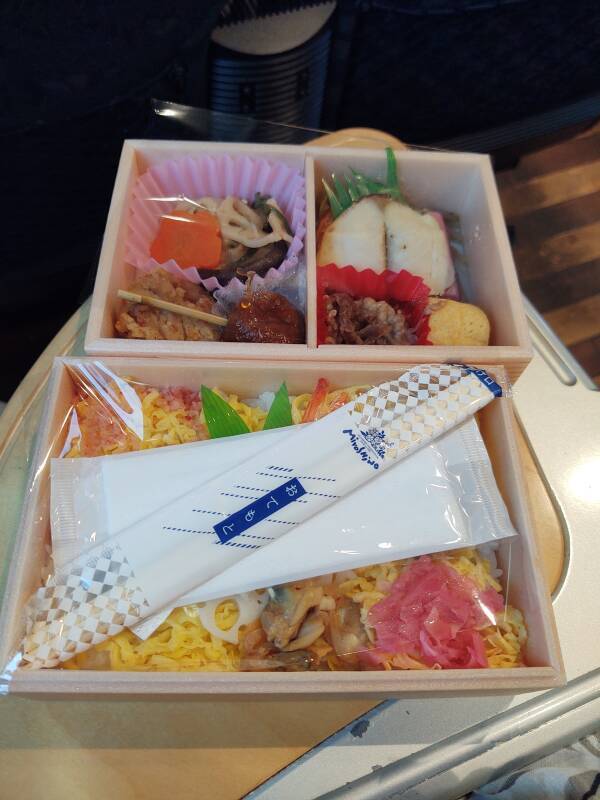

I enjoyed my late lunch as we rolled southeast from Kokura to Ōita. It's an area of agriculture and forestry, known for the kabosu citrus fruit, shiitake mushrooms, saffron, and cedar. And, on this day, a misty mountain hop south to Ōita.

The first people in today's Japan were paleolithic hunters who arrived by walking south from eastern Siberia, back around 35,000–25,000 years ago when sea levels were lowered by the ice age and the Japanese archipelago was connected to the mainland.
What we now consider Japanese culture — a Japonic language, wet-rice agriculture, and the worship of ancestors and kami — arrived with people who crossed the sea from the Korean peninsula to Kyūshū starting around 1000–750 BCE.
They formed a culture called the Yayoi, and around 300 CE they began building distinctive keyhole-shaped megalithic tombs, the kofun. I would see some examples around Ōita.
The Yayoi people living well to the northeast of here, in central Honshū, formed an alliance of local warlords called the Yamato Kingship. The leader of that eventually adopted the title of Son of Heaven, the title used by the Chinese sovereign. The first purported histories of Japan were written in 712–720 CE. They described how the universe was created, and how the ruler was directly descended from the creator gods. That codified some kami worship practices as Shintō while defining the ruler, later called Tennō or Emperor, as a divine "heavenly sovereign".

Note: Those are not UFOs, they're reflections of lights inside the train.
According to the 8th century Chronicles of Bungo, Emperor Keiko (traditionally the 12th Emperor, ruling 71–130 CE) visited this area and gave it a name related to "Land of the Great Fields", which evolved into Ōita.

During the Edo Period of 1603–1867 the Tokugawa Shōgunate ruled from Edo, the fishing village now known as Tōkyō. The warlords of Kyūshū had a degree of independence given their distance from the center of power. That led to some civil wars as the Shōgunate lost power to the Kōmei Emperor and then the Meiji Emperor.

Arrival in Ōita
The train stopped briefly in Beppu, a town known for its many hot springs. Plumes of steam rose everywhere on the dark and misty day. It was time for me to get ready to get off the train in Ōita.
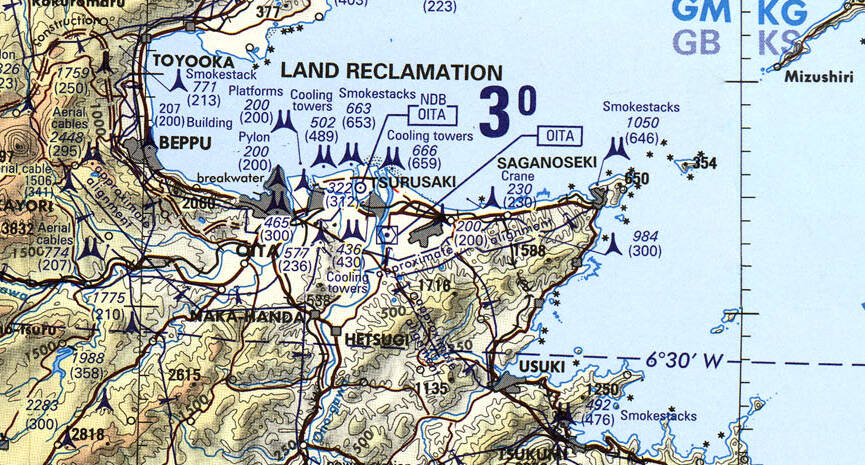
Small portion of 1:500,000 Tactical Pilotage Chart TPC G-11D, from the Perry Castañeda Library Map Collection at the University of Texas. Elevations and tower heights are in feet.
It was only a ten-minute walk from the platform, out through Ōita Station, and down the main street to Hotel 910.
I had reserved a room through Booking.com. That made things a little easier, as the desk staff had very limited English.
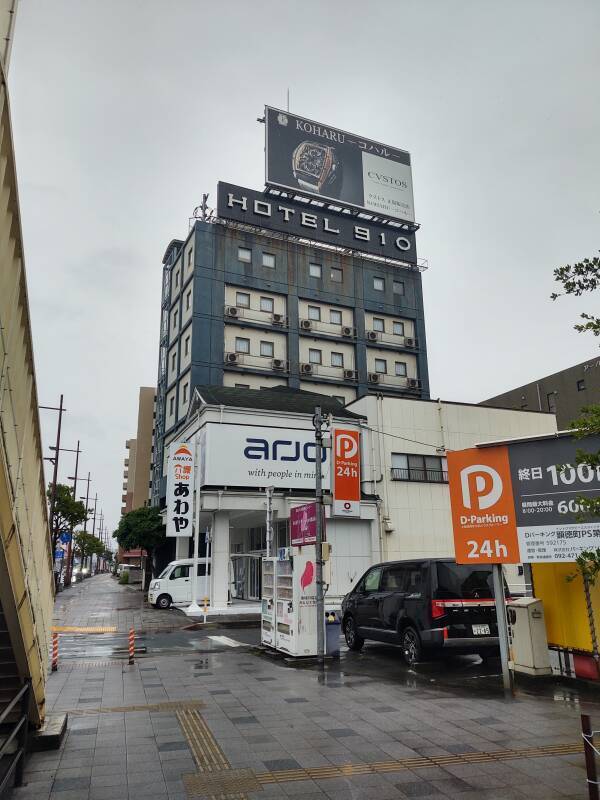
Here's the view from right in front of Hotel 910, looking back toward the train station which is just beyond the telecommunications tower.
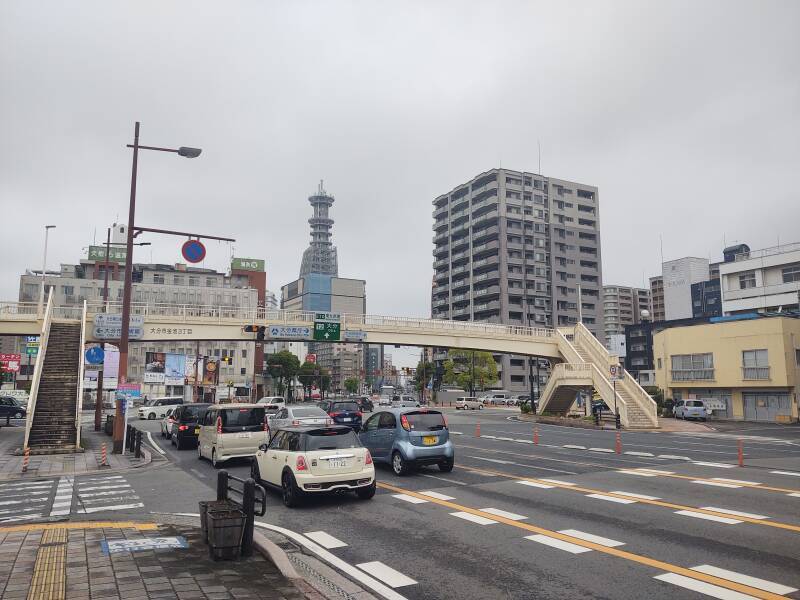
I had a spacious room with refrigerator, TV, and coffee/tea maker.

The bathrooms are built with prefabricated fiberglass modules. Don't trip over the high step through the hatchway!
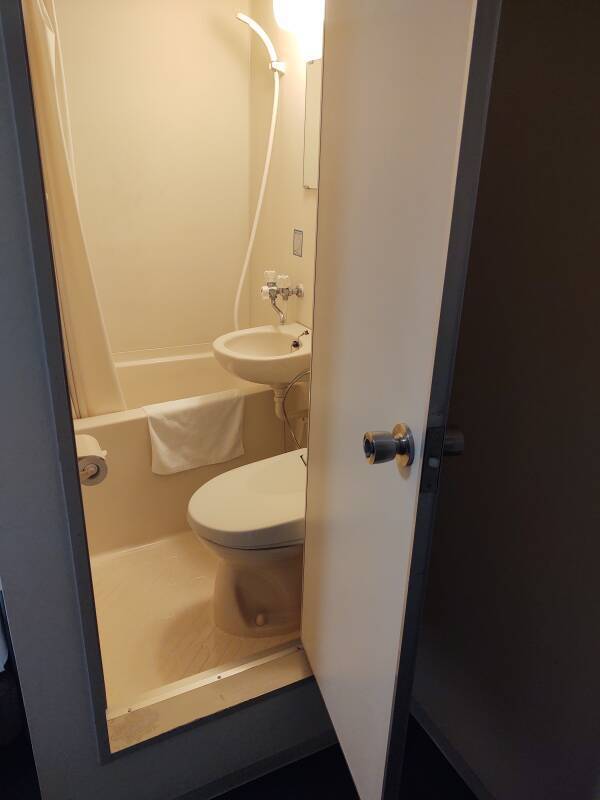
Heating and air conditioning, and a view.

No, that isn't a balcony out there. There's an exterior framework where the heat exchangers are mounted, with rectangular openings for a view over the city.
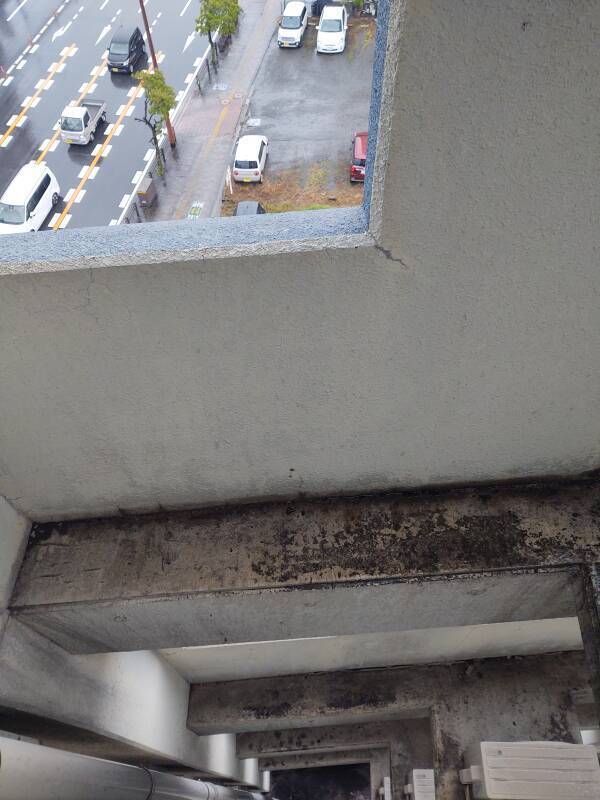

You leave your key at the front desk when you leave, and pick it up when you return. Then you plug the key fob into a socket inside the door, enabling the electrical supply to the lights and climate control. They provide a flashlight in case of emergencies.
Yes, I had enjoyed both a brunch bentō and a late lunch bentō on the trains getting here. But by 20:00 I was ready to venture out to the izakayas around the station for gyoza and spicy noodle soup.
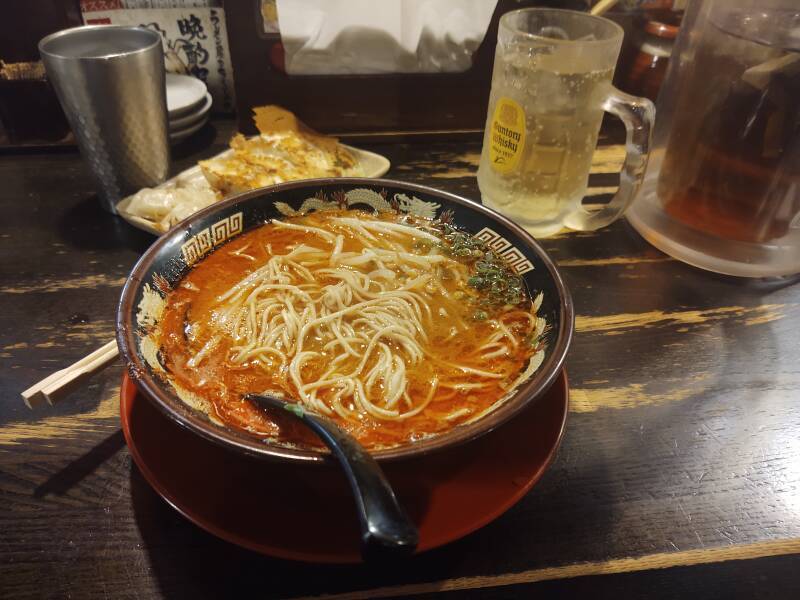
Next❯ To the Tsukiyama kofun
Other topics in Japan:

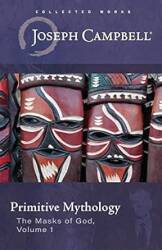
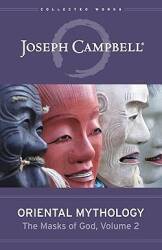




































Kokura is the main rail station in the city of Kitakyūshū.